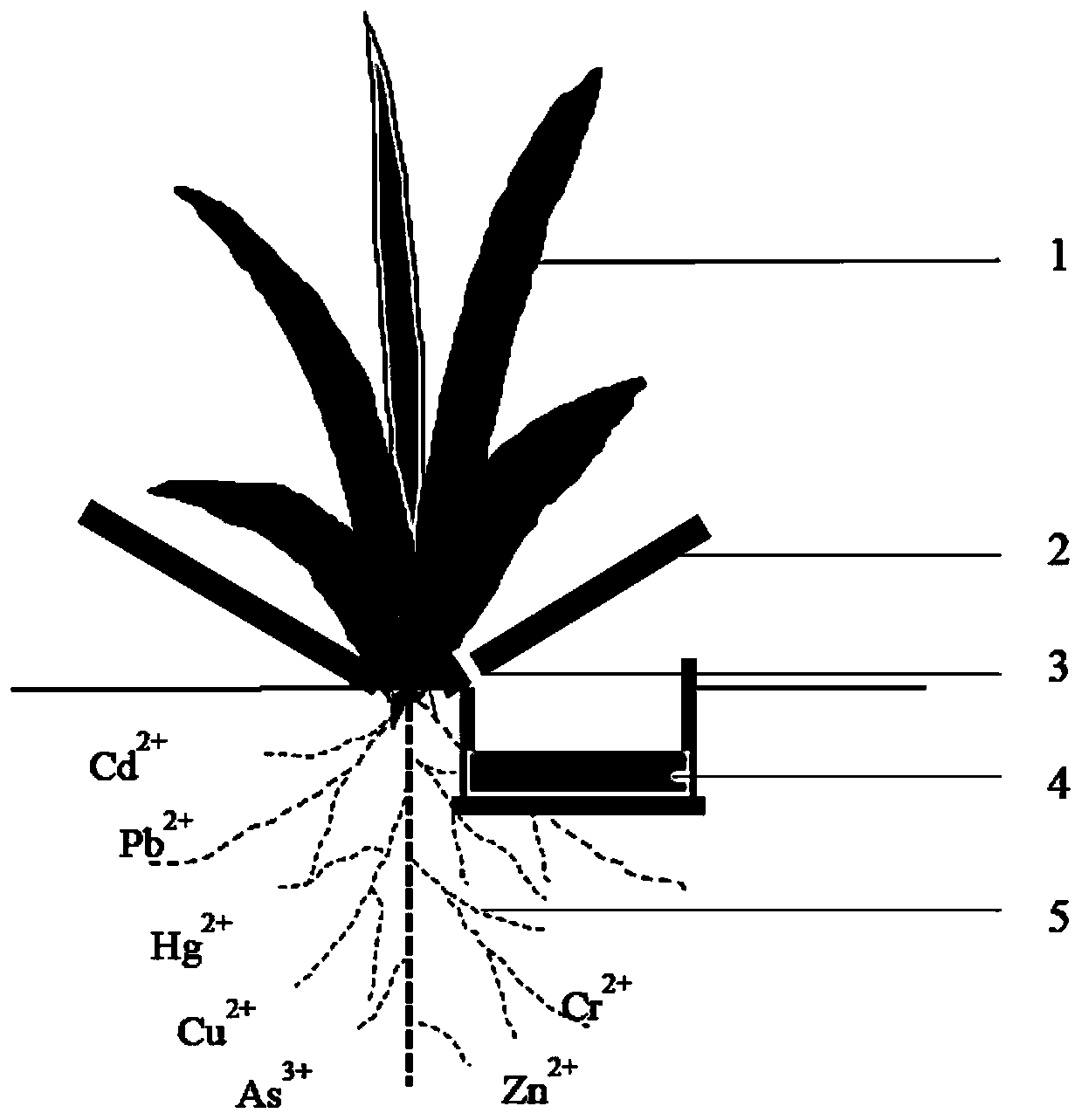Remediation method and device for heavy metal polluted soil based on leaf exocrine mechanism
A technology of heavy metals and leaves, applied in the field of remediation of heavy metal environmental pollution, can solve the problems of difficult treatment, high risk of secondary pollution, secondary pollution of the surrounding environment, etc., and achieves reduction of toxicity, difficulty in secondary pollution, and simple recovery and disposal. Effect
- Summary
- Abstract
- Description
- Claims
- Application Information
AI Technical Summary
Problems solved by technology
Method used
Image
Examples
Embodiment 1
[0024] like figure 1 As shown, the present embodiment relates to a heavy metal eluent collection device comprising: a eluate collection disk 2 set at the base of the plant, a eluate collection port 3 provided at the bottom of the collection disk 2, and a eluate collection port 3 located at the base of the plant. The eluent storage tank 4 under the collection port 3.
[0025] The eluent collection disk 2 is surrounded by an inclination angle of 10-40°, which can smoothly gather the eluent to the eluent collection port 3 at the bottom and flow into the eluent storage tank 4 .
[0026] The eluent collection disk 2 is fixed on the base of the plant, so that the root system of the plant can grow out from the opening in the middle of the disk unhindered and take root in the soil; the eluent collection disk 2 The opening in the center matches the size of the base of the grown plant, and the stems and leaves at the base of the plant can completely block the opening in the middle of t...
Embodiment 2
[0035] In this example, based on the above method and device, Poa annua exocytosis is used to restore heavy metal cadmium-contaminated soil. The specific process is as follows:
[0036] In the soil with a cadmium concentration of 50mg / kg, the bluegrass plants were transplanted in September, and each bluegrass base was covered with a eluent collection device, and the bluegrass plants were collected from the leachate in the middle of the disc. The opening passes through, the stems and leaves are located above the eluent collection disc, the root system is located below the eluent collection disc, and the size of the base of the bluegrass plant matches the size of the opening in the middle of the eluent collection disc. The planting distance between bluegrass and bluegrass is 50mm×150mm. When the plant grows, the root system can absorb heavy metal cadmium pollution from the soil, and transport it to the leaves on the ground, and secrete it to the surface of the leaves through the...
Embodiment 3
[0038] In this example, based on the above method and device, tall fescue exocytosis is used to remediate heavy metal compound polluted soil. The specific process is as follows:
[0039] The soil to be tested is heavy metal complex polluted soil, in which the concentration of lead pollution is 257.5mg / kg, the concentration of cadmium pollution is 34.0mg / kg, the concentration of copper pollution is 1470.5mg / kg, and the concentration of zinc pollution is 1037.2mg / kg. Plant tall fescue plants, each tall fescue base is covered with a eluent collection device, the tall fescue plants pass through the opening in the middle of the eluent collection disc, and the stems and leaves are located in the eluent collection disc above, the root system is located below the eluate collection disc, and the size of the base of the tall fescue plant matches the size of the opening in the middle of the eluate collection disc. The planting row spacing of tall fescue is 200mm×300mm. When the plant grow...
PUM
 Login to View More
Login to View More Abstract
Description
Claims
Application Information
 Login to View More
Login to View More - R&D
- Intellectual Property
- Life Sciences
- Materials
- Tech Scout
- Unparalleled Data Quality
- Higher Quality Content
- 60% Fewer Hallucinations
Browse by: Latest US Patents, China's latest patents, Technical Efficacy Thesaurus, Application Domain, Technology Topic, Popular Technical Reports.
© 2025 PatSnap. All rights reserved.Legal|Privacy policy|Modern Slavery Act Transparency Statement|Sitemap|About US| Contact US: help@patsnap.com


